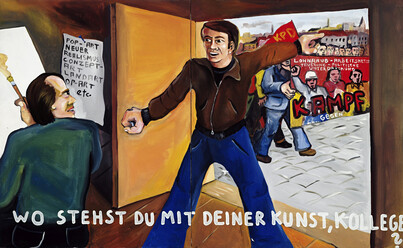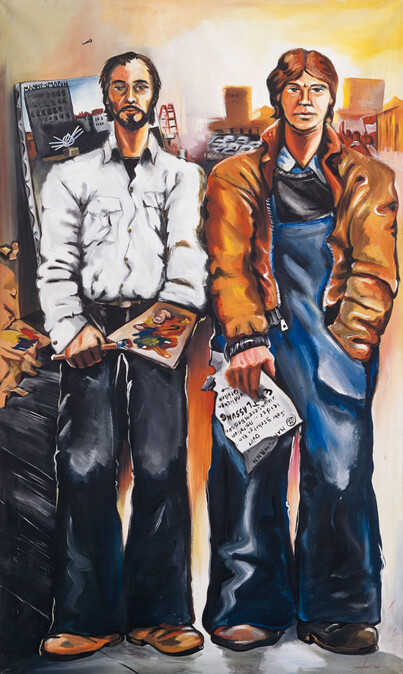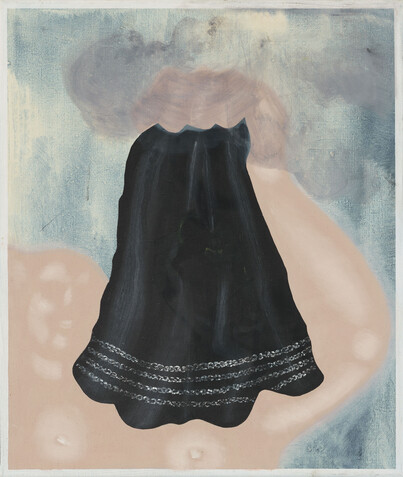Jörg Immendorff
by Michael Bracewell
Reviews /
Exhibition
• 07.01.2019
Two exhibitions surveying the work and career of Jörg Immendorff (1945–2007) bring to a contemporary audience – used perhaps to a more comfortable relation between activism and visual art – the full, complex and troubled impact of a career shaped by militant political action. At the Haus der Kunst, Munich, the major retrospective Jörg Immendorff – For all Beloved in the World comprises nearly two hundred paintings and sculptures, which are arranged into thematic ‘chapters’.
There is a palpable political irony in exhibiting Immendorff’s work – dedicated during the first half of his career to neo-Dadaist actions, left-wing protest and demonstrations – within the vast polished halls of what was once the Nazi Party’s ‘House of German Art’. But this is a vast exhibition, alive with a curious psychic energy, and eloquent of a career that is as much a visionary journey – a post-war pilgrim’s progress – as it is a maturing of ability or ideals.
Many of the paintings are huge – some more than 7 metres wide – and displayed in a salon hang that takes advantage of the galleries’ immensely high ceilings to create a sense of being guided by and enfolded within a visual cosmography. The world depicted in these paintings and sculptures is peopled with archetypes, while also a highly personal journal of events.
Much of the work – especially the more directly propagandist paintings of the early 1970s – has the feel of Outsider or protest art, asserting the importance of politics over art. Paintings chronicling protest and offering edifying guidance to ‘colleague artists’ combine socialist realist themes with a call to political awakening.
Explanatory dogma and crude, cartoon-like illustrations of muscular workers and exuberant, radicalised art students combine to proclaim a call to arms – most memorably, perhaps, in Where Do You Stand With Your Art, Colleague? FIG.1, depicting a leather-jacketed student confronting a fellow artist in his studio as demonstrators march down the street outside. Pinned beside the colleague artist’s easel is a list, flimsy and impotent, that reads: ‘POP-ART, NEUER REALISMUS, CONZEPT-ART, LANDART, OP-ART etc.’.
Immendorff attended the Art Academy in Düsseldorf between 1963 and 1968, where he was a student of Joseph Beuys and greatly impressed by his teacher’s advocacy of art as a consciousness-raising power. Beuys subsequently became a mythic presence in Immendorff’s art, time-travelling as it were from painting to painting, part cosmic teacher, part patron saint.
The earlier paintings – of the late 1960s to late 1970s – were made during a time in which Germany was divided and enduring an economic downturn, the Red Army Faction gained ground and student protests were violently suppressed, written off by the right-wing press as Soviet-sponsored thuggery. The period was oddly reminiscent, in spirit at least, to the Weimar years before the Second World War. There is nervousness, violence and expressionist unease in these works – the sense of a gathering cyclone.
With the nineteen large-format paintings of his ‘Café Deutschland’ series FIG.2, begun in 1978, Immendorff created arguably his masterpiece and certainly his best-known body of work. With the series Immendorff found his subject, one rich with artistic and psychological potential: a crazy, punkish nightclub, part allegory, part imagined theatre of visions. The scenes are dark, chaotic, drunken and vertiginous, recalling somewhat Brecht’s vision of the Rise and Fall of the City of the Mahagonny, which premiered in 1930. Up to the ‘Café Deutschland’ series, Immendorff’s painting style feels subordinate to his political vision. All feels primary, declamatory, vernacular. The dramatic narrative of propaganda and protest creates, collectively, a sense of pictorial urgency that can also become monotonous. In the ‘Café Deutschland’ series, it is as though a new sense of space and action – intensely theatrical, yet utterly controlled – is brought to life by Immendorff’s depictions of darkness and light: the point at which the golden warmth of luminescence becomes sickly and hellish.
The scenes swirl, vortex-like, as though some scene from the Jazz Age has become suddenly peopled by punks and drunks. Figures take their place on the sidelines like extras in a film, or are glimpsed disappearing into pinkish-lit depths. Conversations at the bar are accompanied by splashes of absurdist action – the clatter and movement of chairs, sudden plunging horses, Hitler’s profile, sexual encounters. Immendorff’s brushwork appears loose and gestural, yet supremely assured. His palette veers crazily from rust brown to mauve, gold to ice-blue silver, yet the artist seldom lets slacken the pictorial energy he is bringing to the scenes.
The paintings of the early 1980s seem like a fulcrum – a breaking point in Immendorff’s profoundly self-aware conception of his artistic position. Where does one go after such heartfelt intensity? A small painting titled Kinetic Lovers (1981) brings unexpected intimacy and tenderness. It is a dark, lamp-lit scene of a man and woman seated at a table. Inexplicably but perfectly a third figure lies above them, as though frozen in an electric-blue ice-flow – a dream.
With the fall of the Berlin Wall in 1989, there is the sense that Immendorff lost his subject. He became, perhaps, the chronicler of his own irrelevance (in his eyes), despite by that time being a successful, even famous, artist. In a strange bone-white and gun-metal blue painting of 1981, Suture, Immendorf introduces a form that resembles a flabby starfish, its centre scarred with cruel lacerations, beached on gravel or tarmac. Luminous, sentient, enigmatic, the pallor and vulnerability of this fleshy form (the word ‘Naht’ written centrally beneath it, in scarlet-tinged letters) is at once repellent, sympathetic and arresting. It could signify Immendorff himself, his ideals or Germany. As a painting, it succeeds superbly: it is empathetic and mysterious, yet strangely universal.
At Michael Werner, London, Questions from a Painter Who Reads comprises eighteen paintings and two bronzes. As at the Haus der Kunst, Immendorff’s political work from the 1970s FIG.3 is joined by more recent paintings, which show the artist retreating deeper and deeper into a somewhat Gothic dreamworld, nightmarish and strange FIG.4 FIG.5. Immendorff was diagnosed with nerve disease in 1998. Unsurprisingly, these works appear deeply personal and reflective, suffused with despair.
The open-handedness with which Immendorff shares his ideals and passions is impressive, however coded, crazy or cartoonish his paintings may seem. (Some of his work from the 1990s resembles the art of Robert Crumb.) They are confident, even strident, but there is always an air of anxiety or intense self-scrutiny that enables them to act as sincere reports from stages along life’s way. The noisy student protestor, full of heroics, becomes beset by fears and falls prey to disillusionment, addictions and the perils of success. From the paintings – however odd or crude – there is no trace of posturing or bombast, only human hope and frailty, the usual faults and rare triumphs.
At the Haus der Kunst, Immendorff’s depiction of himself in bronze, Come on, Jorch, Let’s Go! (2003) FIG.6, as a little chimpanzee, led by a cheerily encouraging Joseph Beuys, the two of them striding out to face the world, is worth the price of admission alone.










